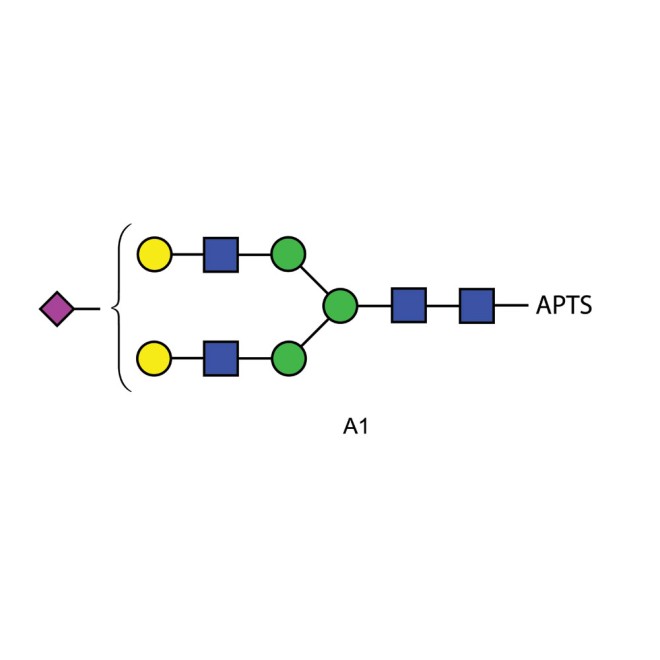A1 glycan (A2G2S1, G2S1), APTS labelled
References
Bunz SC, Rapp E, Neusüss C. Capillary electrophoresis/mass spectrometry of APTS-labeled glycans for the identification of unknown glycan species in capillary electrophoresis/laser-induced fluorescence systems. Anal Chem. 2013 Nov 5;85(21):10218-24. doi: 10.1021/ac401930j. Epub 2013 Oct 15.
Bunz SC, Cutillo F, Neusüß C. Analysis of native and APTS-labeled N-glycans by capillary electrophoresis/time-of-flight mass spectrometry. Anal Bioanal Chem. 2013 Oct;405(25):8277-84. doi: 10.1007/s00216-013-7231-4. Epub 2013 Aug 3.
Patrick JS, Rener BP, Clanton GS, Lagu AL. Analysis of neutral N-linked oligosaccharides from antibodies using free-solution capillary electrophoresis in bare fused-silica capillaries. Methods Mol Biol (2004) 276:137-151.
Wang CY, Hsieh YZ. Analysis of chitin oligosaccharides by capillary electrophoresis with laser-induced fluorescence. J Chromatogr A (2002) 979:431-438
Chen FT, Evangelista RA. Profiling glycoprotein n-linked oligosaccharide by capillary electrophoresis. Electrophoresis (1998) 19:2639-2644.
Guttman A, Chen FT, Evangelista RA, Cooke N.References High-resolution capillary gel electrophoresis of reducing oligosaccharides labeled with 1-aminopyrene-3,6,8-trisulfonate. Anal Biochem (1996) 233:234-242
Guttman A, Chen FT, Evangelista RA. Separation of 1-aminopyrene-3,6,8-trisulfonate-labeled asparagine-linked fetuin glycans by capillary gel electrophoresis. Electrophoresis (1996) 17:412-417.
APTS labelled monosialo biantennary oligosaccharide
Biantennary N-glycan that contains one terminal sialic acid residue, 20pmol.
m/z: 2372.6523
Product Specification
A1 APTS Glycan Synonyms: A1 N-linked oligosaccharide, A2G2S1, G2S1
Description: Mono-sialylated, bi-antennary complex-type N-glycan (oligosaccharide).
Sources: A1 glycan is found on many mammalian glycoproteins including IgG, gamma globulins, and many serum glycoproteins. This product is typically purified from the oligosaccharide pool released from bovine serum by hydrazinolysis using a combination of HPLC and glycosidase digestion.
Form: Dry. Dried by centrifugal evaporation from an aqueous solution. Contains ammonium salt to stabilise against desialylation.
Molecular Weight: 2375
Fluorescence: λex = 425 nm, λem = 503 nm.
Amount: 20 pmols
Purity: >80% pure as assessed by HPLC.
Storage: -20˚C both before and after dissolution. This product is stable for at least 5 years as supplied.
Shipping: The A1 APTS glycan can be shipped at ambient when dry. After dissolution, ship on dry ice.
Handling: Allow the unopened vial to reach ambient temperature and tap unopened on a solid surface to ensure that most of the lyophilized material is at the bottom of the vial. Gently remove the cap, add the desired volume of reconstitution medium, re-cap and mix thoroughly to bring all the oligosaccharide into solution. For maximal recovery of oligosaccharide, ensure that the cap lining is also rinsed and centrifuge the reconstituted vial briefly before use. Ensure that any glass, plasticware or solvents used are free of glycosidases and environmental carbohydrates. Minimise exposure to elevated temperatures or extremes of pH. High temperatures and low pH will cause desialylation. High pH will cause epimerisation of the reducing terminus GlcNAc.
Safety: This product is non-hazardous and has been purified from natural sources certified to be free of all hazardous material including pathogenic biological agents.



-660x660.jpg)
